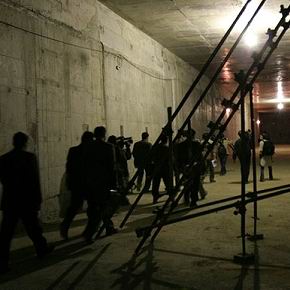 |
||
|
Submarines: The Quiet Bulwark of the Russian Navy RIA Novosti, Konstantin Bogdanov, PUBLISHED March 22, 2012 The Russian submarine fleet is marking its 106th anniversary perhaps not in the best of shapes. Nevertheless, its role today is more important than ever. Today it appears to be fulfilling what might even be called a crucial role. Russia has not even managed to hold onto the position held by the Soviet Union in terms of the number of surface ships and their combat potential (add to that the fact that back then the Soviet Navy was objectively weaker than the American Navy already). The submarine fleet was handed a dubious legacy from the Soviet Union. But the submarine forces, although hit hard after the collapse of the Soviet Union in 1991, have managed to retain far greater potential for recovery than the surface fleet. Military submarines, which officially became part of the Russian Navy back in March 1906, have become the backbone of the Navy and are now its chief asymmetric weapon. Delfin and others A lot of time has elapsed since March 1906 when by Nicholas II’s resolution, which subsequently became a Marine Department order, the Russian Imperial Navy acquired a submarine fleet. Yet the first submarine, called the Delfin, had joined the Baltic Fleet even earlier – in 1904. Since the category of submarine combat vessel did not exist, the Delfin was initially listed as a torpedo boat. The Delfin and a number of other boats were even sent by rail to Vladivostok, where they were deployed on a number of sea missions during the Russo-Japanese war of 1905. The role of submarines has been steadily rising ever since, despite the sporadic attempts at building up the surface fleet. The glory days of the “silent service” were the latter stages of the Soviet Union, during the 1970s and 1980s. History of the Russian submarine fleet The country’s surface ships in fact had very limited combat exposure during World War II and what experience they did have was far from successful, if you take into account the Tallinn crossing of 1941 and the Black Sea tragedy of 1942. The few successes scored by surface ships could not hide the fact that even if the “quiet service” was no more successful than the rest of the Navy, at least it looked more like a regular balanced unit. On the Baltic Sea, underwater warfare went on for years, while on the Black Sea the surface fleet received several painful hits from the German air force and did not display much activity. It was only on the Northern Fleet that the daring torpedo boats sailed to the west to meet the polar convoys. The submarine force operated in parallel: going on sea missions and duty patrols, engaging in communication sessions, trying to break through anti-submarine defenses, and returning home. When the war ended, instead of getting better the situation for the Navy in fact deteriorated further. Not only were NATO forces superior to the Soviet Navy, but NATO’s shipbuilding capacity was head and shoulders above that of the Soviet shipyards (and this is without even counting the inevitable falling behind in technology). Admiral Sergei Gorshkov, the father of the Soviet ocean fleet (who was in office from 1956 to 1985), promoted the concept of an “anti-carrier force”: the main attack core of the Soviet Navy was to neutralize the main fighting core of NATO’s naval force – its aircraft carrier groups. In the triad of anti-carrier forces (surface, underwater and airborne) the submarines took pride of place. The nuclear anti-ship submarines became the main strike force at sea. Surface carriers armed with heavy anti-ship missiles were less combat capable than their underwater cousins, while naval missile-carrying aircraft were not strictly speaking a means of gaining control of the seas. The 1960s saw the start of the race between the “city busters”: the Soviet Navy began competing with the American fleet for domination of naval strategic nuclear forces. Missile-carrying submarines on patrol duty cruised around the target areas, waiting for the command to strike. They were closely stalked by enemy boats tasked with thwarting their mission. Duels over the bottomless depths occasionally ended in clashes. On March 20, 1992, the K-407 missile-carrying submarine collided with the U.S. submarine Grayling, which had been eavesdropping on its Soviet counterpart. Earlier, in May 1981, the K-211 missile-carrying submarine had also had a brush with an unidentified boat while returning to base. On February 11, 1992, the Russian Project 945 hunter-killer submarine (believed to be the K-239) when trying to surface collided with the U.S. submarine Baton Rouge, which had been spying on it, and had lost its trail. Unable to challenge the U.S. surface ships to any meaningful extent, the Soviet Navy was forced to move underwater. This is not strictly speaking true, since heavy missile-carrying cruisers and large anti-submarine ships regularly plied the oceans. But the emphasis shifted: with the surface force falling behind, the nuclear submarines started assuming an increasingly important role. In the early 1980s, the Soviet Union managed to get past the tight system of export control and succeeded in importing milling machines capable of producing submarine propellers with a much better surface quality, which helped the main defect of Soviet submarines – their high noise level – to be overcome. The next generation of submarines was also on its way. Some of the plans for them are currently being implemented: the frequently redesigned Project 955 Borei class submarine and the Project 885 multi-purpose Yasen-class submarine. Into the 21st century Submarines today are still the asymmetric weapon of the Russian Navy, almost to an even greater degree than before 1991. The massive collapse of Russia’s presence in the world’s oceans has led to the mass decommissioning of warships. The boats suffered too, and quantitatively perhaps even more so, but the active surface force is now so diminished that the role of the submarines can only keep growing. In the long run, it is they who will bear the main burden of combat service. Venturing out into the oceans is now decidedly difficult: despite cutbacks, the U.S. Navy is still capable of squeezing out anyone who encroaches on Washington’s naval might. Competing with the United States in terms of the number of nuclear anti-aircraft carriers escorted by missile-carrying cruisers is impossible. It is equally impossible to compete in operations in remote theaters: both in terms of provision of ships and overseas bases. But that is on the surface. Underwater, Russia’s chances are different, although still not that bright. Below the surface Russian submariners are perfectly capable of putting up a fight against any potential opponents. The equipment available to them (and that under development) makes the outcome of underwater warfare far less predictable than on the surface. Russia may not have the money to build a large ocean-going fleet. That is the historical fate of Russian shipbuilding: it is too weak to manufacture ships on a commercial, batch-produced basis. Its bases and repair facilities are equally under strength – the Soviet and Russian navies have both had to deal with the same kinds of problems for 100 to 150 years. As for the submarines, they have been with us since the Russian Empire, maintaining Russia’s naval tradition by being the backbone of the Navy. They are likely to remain so for a long time – if not forever. Topics: Russia, Nuclear ships Other news: IAEA Delegation Arrives in Iran to Discuss Nuclear Program The IAEA delegation is led by Herman Nackaerts who is in charge of the Iran nuclear file. Prokhorov Suggests Moving Skolkovo to Kaliningrad In my view, the hi-tech hub should not be constructed in Moscow. I suggest moving Skolkovo to Kaliningrad. Rosatom Managers Sacked, Fined over Corporate Party According to the Dozhd TV channel, the corporation paid 12.5 million rubles (about $400,000) for the New Year’s bash. |
Hero of the day 
Iran views of its nuclear issue It is difficult to say what will happen next, especially since the international community is split into two opposing camps on this issue. This article will analyze both of them, also taking into account the situation in Tehran. INTERVIEW
Georgy Toshinsky OPINION
Ivan Zakharchenko |

